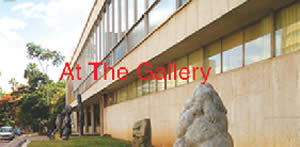National Gallery of Zimbabwe at 60

Dedicated to the presentation, promotion and conservation of Zimbabwe’s contemporary art and visual heritage, the National Gallery of Zimbabwe is set to celebrate its 60th anniversary in 2017. As one of the oldest art institutions in Zimbabwe, established in 1957, the National Gallery of Zimbabwe has witnessed the dramatic transition from the colonial era to Independence. It has played a tremendous role in the rise of Zimbabwean artists on both local and international platforms such as the Venice Biennale and travelling exhibitions such as the Kabboka Muwala (The Girl’s Basket) which travelled from Harare to Kampala and Bremen.
“2017 is the year in which the NGZ turns 60 having been in existence since 1957, it’s a milestone. It is an opportunity for us to stop and reflect on our roles and journeys in bringing the arts to our own community. 2017 is a year of celebration and are looking forward to it.
“We are celebrating that this institution has been able to transition itself from a colonial institution into a post colonial African learning and creative hub. It has increased relevance to the majority of the population and has also been on the fore front in terms of visual art success and visual art heritage,” said Mrs Doreen Sibanda the executive director of the National Gallery of Zimbabwe.
In the 50s when the National Gallery opened, it was essentially an institution for the white community and the idea of creating an art gallery was based on wanting to mimic European institutions whilst showcasing Western art. However, the first National Gallery director Frank McEwen who had been hired by the Rhodesian authorities to introduce European high art into the National Gallery of Rhodesia, had a subversive intention from the very beginning. This was seen in how he was determined from his arrival to develop and then popularise the art of local black people. He wanted to ensure that the Rhodesian public including black people were exposed, and were able to engage in art and culture from around the world.
“Frank McEwen was of a different view from local Rhodesian authorities since he was coming from Paris where they were looking outside of European civilisation for inspiration. With that background McEwen came here with the view that there must be something explicit about this place and therein was its importance to reawaken Zimbabwean art and to promote it.
“By the 1960s and 1970s there was a huge renaissance of Zimbabwean artistic creativity and along that a great deal of international success. This new art was largely using the medium of stone, a medium which was already familiar to our ancestors here in Zimbabwe and it led to the internationally acclaimed stone sculpture movement. However, the stone occupation didn’t mean that there were no other skills inherent there in. Rock painting and other objects in local material culture point to a continuation of indigenous forms of expression, high skill and creativity. Soon after Independence, the National Gallery purposefully promoted and reinforced this narrative,” said Mrs Sibanda.
Zimbabwean art has since diversified and moved and developed into what is now recognised as the contemporary art scene. The National Gallery of Zimbabwe has nurtured many artists who are raising the country’s flag high in both the local and international art scene. This has been seen through the staging of the Zimbabwe Pavilion at the Venice Biennale which has managed to excite diverse audiences with many wanting to be associated with the institution’s brand.
The year 2017 has a variety of interesting and engaging shows lined up for the celebration of the 60th anniversary. There will be shows of Zimbabwean cutting edge Contemporary art from Africa, tribute shows to late modern artists as well as international collaborations. There will indeed be greater public programming so that audiences can access exhibitions and programmes. The Gallery will for the fourth time, present a Zimbabwean Pavilion at the Venice Biennale. This platform can be described as the Art Olympics and once again Zimbabwe will have a significant presence there.
More over the National Gallery is set to host its second International Conference on African Art and Culture in September. The first Congress of African Art and Culture was held in 1962 and it established the gallery in the eyes of the International Community as a centre of the advancement of African studies, and the promotion of African art. It was the first forum ever in which the arts of Africa were discussed by Africans in Africa. Many of the delegates were, of course, academics from the US and the UK, but there was a significant number of delegates from West and Central Africa, where the philosophies of Negritude and Pan-Africanism were popularly debated and supported.
“In all great countries of the world art galleries and art museums have their place in the cultural life of the community”, as stated by Sir Stephen Courtauld who once presided as Chairman of the National Gallery’s Board until 1962. The National Gallery of Zimbabwe is no exception, it has held a firm place within the past, present, and will continue to do so in the future of the Zimbabwean community and arts sector.
The National Gallery focuses not only on presentation, conservation and research, but also on art education. At the National Gallery School of Visual Art and Design talented young artists are trained in various fields of artistic practice. The National Gallery will continue in its primary objectives to facilitate outreach programmes for underprivileged school children, training workshops, film screenings, music concerts and world class exhibitions in 2017.











Comments